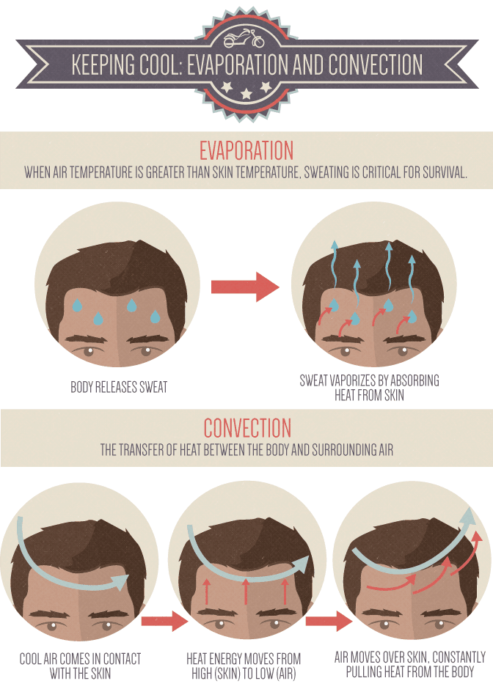Riding long distance in Australia’s hot weather has its own challenges particularly when the temperature climbs.
While we prefer the warmer days rather than Touring long distance in the middle of Winter, riding in the Summer motorcyclists still need to prepare.
Motorcyclists can be exposed to health problems caused by dehydration and increase in core temperature which can cause heat stroke, heat exhaustion, and heat cramps.
During hot weather, air temperature rises above that of the human skin making the three mechanisms (convection, radiation and conduction) that keep the body cool ineffective.
The body regulates body temperature by sweating. As the sweat is released to the surface of the skin evaporation occurs and the body cools.
“Motorcyclist experience the opposite of “wind chill;” a light breeze can enhance evaporative cooling but over 34°C a strong wind is heating the body.”
Evaporation is the primary method for keeping the body cool. It works through the principle of latent heat of vaporization.
Latent heat is the energy released or absorbed when a substance, in this case, water, has changed its state from liquid to vapor.
This energy is drawn out from the body in the form of heat to help cool you down. This normal regulation is often distorted during hot weather.
The obvious response is to wear full riding gear that includes a mesh riding suit to maximize airflow.
How the Body Regulates Temperature
However, even vented riding gear does not work in these conditions. This is because, insulation is rendered ineffective when the body gets heated up from within once the heat is generated through metabolism and can’t be released.
As such, the body needs to be in contact with cooler surroundings than its core temperature to keep it cool. The body regulates heat through convention, radiation, conduction, and evaporation. Convection is the transfer of energy through moving air.

When the air and the skin are at different temperatures, heat transfer occurs from areas with high temperature to regions with low temperature. As the heat is emitted from the body through evaporation, it warms the air surrounding the skin. Wind then pulls the air away from the skin and replaces it with cool air leaving skin feeling fresh.
However, when the temperature rises above 34 degrees Celsius, the surrounding air becomes hot, causing your body to heat up. It explains why the amount of heat entering the body through convection increases as the riders travel at high speeds in high temperatures.
As such, it is advisable to wear more clothing to increase the amount of heat lost through evaporation. Long-sleeved and tight-fitting shirts made using moisture-wicking material come in handy. As sweat evaporates through the moisture-wicking garments, the body cools. On the contrary, convectional materials only trap sweat and limit evaporation causing the shirt to become wet.
How Evaporative Cooling Works
Evaporation is the primary cooling mechanism associated with sweat. It becomes the dominant cooling method when air temperature exceeds that of the skin, i.e., higher than 34 degrees Celsius.
The process is known as evaporative cooling, and it is critical to survival in extreme temperatures.
Evaporative cooling works best on the areas of the body with large blood vessels close to the skin, e.g., the neck and the groin.
It explains why it is essential to wear something wet around the neck. Evaporative cooling is only as effective as the level of humidity. When the humidity is high, neither sweat nor water on a neckband evaporate effectively; and, limited evaporation means your body does not cool as well.
Riders need to take more breaks or travel in the early morning hours when it is cool and rest in the afternoon to survive these conditions.
A wet bandana around your chin will keep you cool a few minutes, but the hot wind causes the water to evaporate pretty fast.
It is important to keep replenishing the water after every few minutes or wear a fabric that holds more water.
Watch out for early stages of dehydration usually have no signs or symptoms, but can include dryness of the mouth and thirst.
Symptoms of early or mild dehydration may include:
- passing less urine than normal
- cramping in the arms and legs.
- headache;
- tiredness;
- dizziness;
As dehydration increases, signs may include:
- extreme thirst and parched mouth and tongue
- rapid pulse
- dark, yellow urine;
- little or no urination;
- sunken eyes;
- irritability or drowsiness; and
- irrational behaviour.
- skin that has lost its elasticity and doesn’t quickly return to its normal position after being pinched
How to Survive the Hot Weather
Hydrate – You need to take lots of water to replenish the sweat glands and electrolytes. The amount of water you need to depends on the air temperature. At least 500ml. of water after every four hours helps achieve evaporative cooling when the temperature increases.
As the temperature increases, you need to take more water to achieve evaporative cooling. Riders travelling in deserts with temperatures of 40 degree Celsius or higher will be drinking over 1 litre per hour to stay hydrated.
Riders should avoid taking alcoholic drinks. Such drinks stimulate abnormal heartbeats, dehydrate the body, and depress the pumping function of the heart. Certainly, no binge drinking.
Wear Wicking Garments
It is essential to wear undergarments that remain in contact with the skin to reduce any loss of perspiration before evaporation. A helmet liner comes in handy because of the large surface area of the head and amount of sweat wasted if a wicking material does not trap it.
Take Regular Stops – The best way to refresh your body is to get out of the heat to a cooler setting. Plan your trip along routes that have fuel stations, motels, shady parks, towns, or scenic rivers not too far from each other. Smartphone apps help in route planning ahead of time.
Also, with higher areas getting are cooler, consider taking an alternate road with a higher elevation. If there’s no alternative route, adjust your schedule, so you can head out after dark and rest during the day.
Use Suntan Lotion
- Use Blockout 30+ suntan lotion on the back of your neck and any exposed parts of your face.
- If you are wearing shorter summer gloves the back of the wrists
Dress for the Heat
- The helmet should ideally be in bright, light colors with open vents to facilitate airflow
- Wear textile mesh jackets instead of perforated leather jackets
- Wear all-weather gloves. Their inner surfaces are enhanced with gel foam padding
- Look for moisture-wicking socks
“Consider adding some base layer options to maximize comfort, cooling and facilitate airflow”
When the temperature is below 34c., it is easy to remain cool on a motorcycle as long as you are moving fast enough to facilitate convectional cooling.
However, temperatures above 34c require a different cooling mechanism (evaporative cooling) by reducing exposure to the wind, wearing wicking undergarments and dressing for hot weather.


